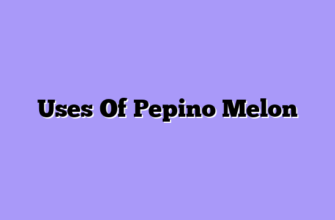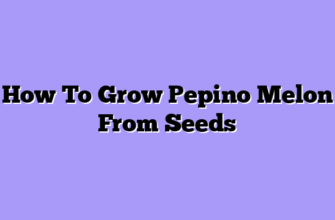Hey there, green thumbs and curious gardeners! Ann here, your friendly neighborhood exotic fruit farmer. Today, we’re diving deep into the world of pepino melon seeds. Whether you call them melon pears, tree melons, sweet cucumbers, or by their fancy scientific name Solanum muricatum, these little seeds hold the key to growing your very own pepino paradise. So, let’s get our hands dirty and explore everything you need to know about pepino melon seeds!
The Tiny Powerhouses: Understanding Pepino Seeds
First things first, let’s take a closer look at these little miracles. Pepino melon seeds are tiny, flat, and oval-shaped, similar to tomato seeds. They’re usually a pale yellowish color and measure about 3-4 millimeters in length. Don’t let their small size fool you, though – these seeds pack a punch when it comes to growing potential!
One interesting thing about pepino seeds is that they’re surrounded by a gel-like substance inside the fruit. This gel contains growth inhibitors that prevent the seeds from germinating while they’re still inside the fruit. It’s nature’s way of saying, “Hold your horses! It’s not time to grow yet.” Pretty clever, right?

But don’t let that discourage you from experimenting with seeds. Growing pepinos from seeds can be a fun and rewarding experience, especially if you’re into plant breeding or just love a good gardening adventure. Plus, who knows? You might end up creating a whole new variety of pepino!
Seed Extraction: Getting to the Heart of the Matter
So, you’ve decided to try your hand at growing pepinos from seeds. Great choice! The first step is to extract those tiny seeds from the fruit. Here’s how I do it:
Start with a fully ripe pepino melon. You want one that’s nice and soft, with a strong aroma. Cut the fruit in half lengthwise and scoop out the seeds with a spoon. You’ll notice they’re surrounded by that gel I mentioned earlier. Don’t worry – we’re going to get rid of that.
Place the seeds and gel in a glass of water and gently squish them around with your fingers. This helps separate the seeds from the gel. Let the mixture sit for about 24 hours. During this time, the good seeds will sink to the bottom, while any duds will float to the top along with the pulp.
After 24 hours, pour off the water and pulp, keeping only the seeds that sank to the bottom. Rinse these seeds well under running water, then spread them out on a paper towel to dry. And voila! You’ve got yourself some prime pepino seeds ready for planting.
Are Pepino Melon Seeds Edible?
Yes, Pepino Melon seeds are indeed edible. However, there are a few important points to consider:
- Size and Texture: Pepino Melon seeds are quite small and soft compared to many other fruit seeds. They’re similar in size and texture to tomato seeds.
- Taste: The seeds don’t have a strong flavor of their own. They tend to take on the taste of the fruit’s flesh surrounding them.
- Consumption: Most people eat the seeds along with the fruit without even noticing them due to their small size and mild flavor. There’s usually no need to remove them before eating the fruit.
- Nutritional Value: While edible, the seeds are so small that their nutritional contribution is minimal. The fruit’s flesh is where most of the nutrients are found.
- Digestion: The seeds are easily digestible and shouldn’t cause any issues for most people when consumed as part of the whole fruit.
It’s worth noting that unlike some fruits where the seeds are specifically consumed for their nutritional benefits (like pomegranate or chia seeds), Pepino Melon seeds are typically eaten incidentally along with the fruit rather than as a targeted food item.
Germination: Waking Up the Seeds
Now comes the exciting part – germinating your pepino seeds! These little guys can be a bit finicky when it comes to sprouting, but with a little patience and the right conditions, you’ll see those first tiny leaves in no time.
Pepino seeds like it warm, so aim for a soil temperature of around 70-80°F (21-27°C). I like to use a seed-starting mix that’s well-draining but retains some moisture. Fill some small pots or a seed tray with your mix, then plant the seeds about 1/4 inch deep. Water them gently and cover the pots with plastic wrap to create a mini greenhouse effect.
Place your seeds in a warm spot – on top of a refrigerator or near a radiator works well. Just make sure it’s not too hot! Some folks use heat mats designed for seed starting, which can be a great investment if you’re serious about growing from seeds.
Now, here’s where patience comes in. Pepino seeds can take anywhere from 2 to 4 weeks to germinate. I know, I know – it feels like forever when you’re excited about your future pepino plants. But trust me, it’s worth the wait. Keep the soil moist but not waterlogged during this time, and before you know it, you’ll see those first tiny sprouts pushing through the soil!
Seedling Care: Nurturing Your Baby Pepinos
Congratulations! Your pepino seeds have sprouted. But don’t break out the celebration dance just yet – we’ve still got some growing to do. Caring for pepino seedlings is a delicate balance of providing the right amount of light, water, and nutrients.
Once your seedlings have emerged, remove the plastic cover and move them to a spot where they’ll get plenty of light. Pepinos love the sun, but young seedlings can be sensitive to intense direct light. I like to use grow lights or place them near a bright window with some sheer curtains to filter the light.
Water your seedlings carefully, keeping the soil moist but not soggy. Overwatering is a common mistake with young plants and can lead to damping off, a fungal disease that’s a real seedling killer. I like to water from the bottom by placing the pots in a tray of water for a few minutes, allowing the soil to soak up what it needs.
When your seedlings have developed their first true leaves (the ones that come after the initial seed leaves), it’s time to start feeding them. Use a diluted liquid fertilizer formulated for seedlings, applying it every other week. Remember, when it comes to fertilizing young plants, less is more!
Transplanting: Moving to Their Forever Home
As your pepino seedlings grow, they’ll eventually outgrow their starter pots. When they’re about 4-6 inches tall and have a good set of true leaves, it’s time to think about transplanting. But before you do, you need to harden them off.
Hardening off is the process of gradually acclimating your seedlings to outdoor conditions. Start by placing them outside in a sheltered spot for an hour or two each day, gradually increasing the time over a week or two. This helps prevent shock when you finally plant them in their permanent home.
When you’re ready to transplant, choose a spot in your garden that gets full sun and has well-draining soil. Pepinos like rich soil, so mix in some compost or well-rotted manure before planting. Space your plants about 3 feet apart to give them room to grow.
Here’s a pro tip: even though your pepinos are grown from seed, they’ll appreciate some support as they grow. I like to set up a trellis or cage when I transplant, to avoid disturbing the roots later on. Your pepino plants will thank you by producing loads of delicious fruit!
The Waiting Game: From Seed to Fruit
Now that your pepino plants are in the ground, you might be wondering how long until you can enjoy the fruits of your labor. Well, I hate to break it to you, but growing pepinos from seed takes patience. From the time you plant your seeds, it can take anywhere from 4 to 6 months before you’re biting into your first homegrown pepino.
But don’t let that discourage you! The journey from seed to fruit is a fascinating one. You’ll get to watch your plants grow and develop, see their first flowers bloom, and finally, witness the tiny fruits start to form and ripen. It’s like being part of a little miracle of nature.
Plus, there’s something special about growing a plant all the way from seed. It gives you a deeper appreciation for the fruit and a sense of accomplishment that’s hard to beat. And who knows? Your seed-grown pepinos might just be the sweetest, most delicious ones you’ve ever tasted!
Seed Saving: Continuing the Cycle
Once you’ve successfully grown pepinos from seed, you might want to try saving seeds from your own fruit for next year’s crop. It’s a great way to select for traits you like and potentially develop your own unique pepino variety over time.
To save seeds, choose your best, ripest fruits. Follow the same extraction process we discussed earlier, making sure to clean and dry the seeds thoroughly. Store them in a paper envelope in a cool, dry place, and they should stay viable for about a year.
Remember, though, that pepinos are often hybrids, so the fruit from your saved seeds might not be identical to the parent plant. But that’s part of the fun of seed saving – you never know what delicious surprises you might create!
Wrapping Up: The Joy of Growing from Seed
Well, folks, we’ve covered a lot of ground today, from the tiniest pepino seed to a flourishing plant heavy with fruit. Growing pepinos from seed might take a bit more time and effort than starting from cuttings, but it’s an adventure that every gardener should try at least once.
There’s something magical about nurturing a plant from seed to fruit. It connects you to the full cycle of plant life and gives you a deeper appreciation for the food you grow. Plus, the pride you’ll feel when you bite into that first pepino, knowing you grew it all the way from a tiny seed? Absolutely priceless.
So go ahead, give it a try! Start some pepino seeds, nurture those seedlings, and before you know it, you’ll be harvesting your very own unique pepinos. And who knows? You might just discover a brand new variety that’ll make you the talk of the exotic fruit world. Happy growing, everyone!








